“Microwave-Safe or Not? The Ultimate Guide to Using Ceramic Plates” is a great headline for a blog post on this topic. It suggests that the content will provide readers with comprehensive information about the safety of ceramic plates in microwaves and how to use them effectively. This headline is likely to capture the interest of readers who want to ensure they are using their kitchenware safely and correctly.
Are Ceramic Plates Microwave Safe?
In the modern kitchen, the microwave has become an indispensable appliance, allowing us to quickly heat and cook a variety of foods. As we use the microwave daily, questions about the safety of different materials inside it arise. Ceramic plates are a common kitchen staple, but are they truly microwave safe? In this comprehensive guide, we’ll delve into the intricacies of ceramic plates and their compatibility with microwaves, helping you make informed decisions for a safer and more convenient cooking experience.
Understanding Ceramic Composition:
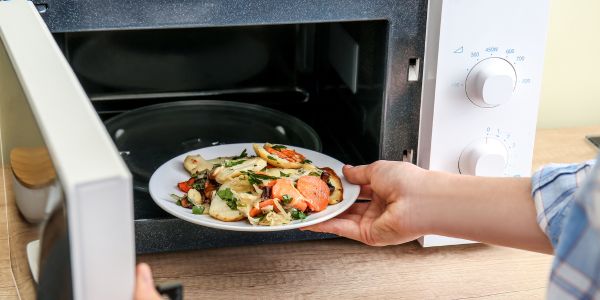
Ceramic plates are known for their aesthetic appeal and versatility, making them a popular choice for serving and dining. However, not all ceramics are created equal, and their microwave compatibility largely depends on their composition. Ceramics are a broad category of materials that include earthenware, stoneware, and porcelain, each with varying levels of heat resistance.
Factors Influencing Microwave Safety:
- Glaze Quality: The glaze applied to ceramic plates plays a crucial role in determining their microwave safety. A high-quality glaze forms a protective barrier that prevents moisture absorption, reducing the risk of cracks and explosions during microwave use.
- Metallic Elements: Some ceramics contain metallic elements like gold or silver for decorative purposes. Metallic elements can cause sparking in microwaves, potentially damaging the plate and the appliance. It’s essential to check whether your ceramic plate has any metallic embellishments before microwaving it.
- Air Pockets and Imperfections: Poorly made ceramics might have air pockets or imperfections in their structure. When exposed to microwave radiation, these imperfections can lead to sudden cracking or shattering due to rapid expansion.
Conducting the Microwave Test:
One simple method to determine if a ceramic plate is microwave safe is to perform a microwave test. Place the ceramic plate in question alongside a microwave-safe glass container filled with water. Microwave the items for a minute on high power. If the plate remains cool to the touch while the water heats up, it’s likely microwave safe. However, if the plate becomes hot or exhibits any signs of cracking, it’s best to avoid microwaving it.
Manufacturer’s Guidelines:
When in doubt about a ceramic plate’s microwave safety, always consult the manufacturer’s guidelines. Reputable manufacturers provide information about the intended use of their products, including whether they are suitable for microwave use. This information can often be found on the packaging or the manufacturer’s website.
Tips for Safe Microwave Use of Ceramic Plates:
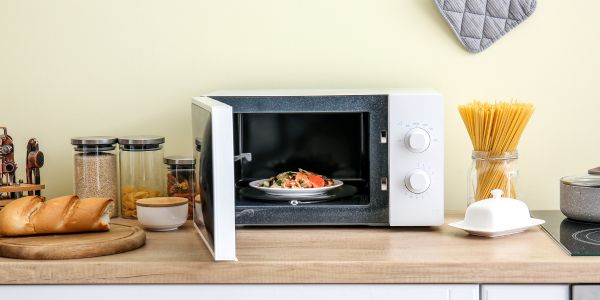
- Avoid Extreme Temperature Changes: Ceramic plates, like any ceramic material, can be sensitive to sudden temperature changes. To prevent cracks, avoid placing a cold ceramic plate directly into a hot microwave or vice versa.
- Use Microwave-Safe Covers: If you want to cover food on a ceramic plate while microwaving, opt for microwave-safe covers made from materials like microwave-safe plastic wraps, microwave-safe silicone lids, or microwave-safe paper towels.
- Mindful Heating: When reheating or cooking food on a ceramic plate in the microwave, use shorter time intervals and check the progress frequently. Stirring the food also helps distribute the heat evenly and reduces the risk of overheating the plate.
- Inspect for Cracks: Regularly inspect your ceramic plates for any signs of cracks or imperfections. Avoid using plates with even minor cracks in the microwave, as they can worsen under microwave radiation.
Is ceramic plate safe in microwave?
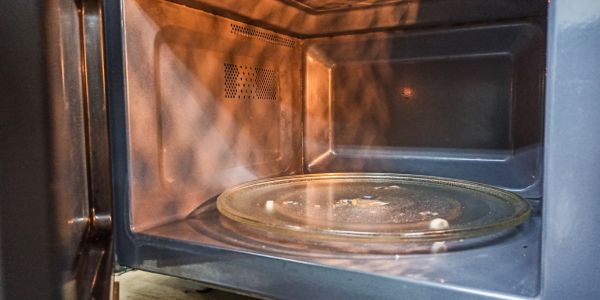
Yes, in general, ceramic plates are safe to use in a microwave, but there are a few important considerations to keep in mind to ensure their safe usage.
Quality and Composition: The safety of ceramic plates in a microwave depends on their quality and composition. High-quality ceramic plates with a smooth and solid glaze are more likely to be microwave-safe. The glaze acts as a protective barrier that prevents moisture absorption and reduces the risk of cracking or shattering.
Metallic Elements: Be cautious if the ceramic plate has metallic elements or decorations, such as gold or silver accents. Metallic elements can cause sparking in the microwave, potentially damaging the plate and the appliance. If the plate has any metallic parts, it’s best to avoid microwaving it.
Microwave Testing: One way to test whether a ceramic plate is safe for microwave use is the microwave test. Place the plate in question alongside a microwave-safe glass container filled with water. Microwave the items for a short duration, such as one minute, on high power. If the plate remains cool to the touch while the water heats up, it is likely microwave-safe. However, if the plate becomes hot or exhibits any signs of cracking, it’s better to avoid using it in the microwave.
Manufacturer’s Guidelines: Always refer to the manufacturer’s guidelines and instructions. Reputable manufacturers provide information about whether their ceramic plates are microwave-safe. This information can usually be found on the packaging or the manufacturer’s official website.
Safe Microwave Practices:
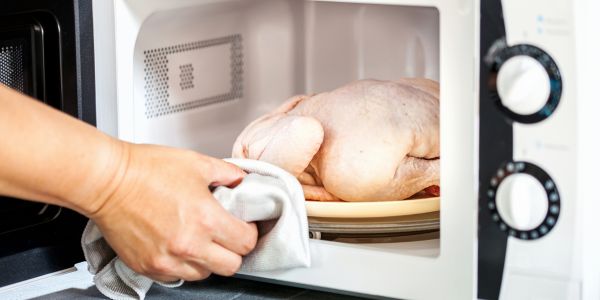
When using ceramic plates in the microwave, consider the following safe practices:
- Avoid Extreme Temperature Changes: Ceramic plates can be sensitive to sudden temperature changes. Avoid placing a cold ceramic plate directly into a hot microwave or vice versa, as this can lead to cracking.
- Use Microwave-Safe Covers: If you want to cover food on a ceramic plate while microwaving, use microwave-safe covers made from materials like microwave-safe plastic wraps, silicone lids, or microwave-safe paper towels.
- Mindful Heating: Use shorter time intervals and check the progress frequently when microwaving food on a ceramic plate. Stirring the food can help distribute heat evenly and reduce the risk of overheating the plate.
- Inspect for Cracks: Regularly inspect your ceramic plates for any cracks or imperfections. Avoid using plates with even minor cracks in the microwave, as they can worsen under microwave radiation.
In conclusion, ceramic plates can be safe for microwave use if they are of good quality, have a proper glaze, and do not contain metallic elements. To ensure safety, perform the microwave test, follow manufacturer guidelines, and practice safe microwave habits.
How i understand my ceramic plate is microwave safe?
Understanding whether your ceramic plate is microwave safe involves a combination of factors. Here’s a step-by-step guide to help you determine if your ceramic plate can be safely used in the microwave:
Check for Manufacturer’s Label: Look for any labels, stickers, or markings on the plate’s packaging or the plate itself that indicate whether it’s safe for microwave use. Manufacturers often provide this information to help consumers make informed decisions.
Examine the Glaze: A high-quality glaze is crucial for microwave-safe ceramic plates. Inspect the surface of the plate for a smooth and even glaze. Avoid plates with rough or cracked glaze, as they might absorb moisture and heat unevenly, leading to potential cracking or shattering in the microwave.
Metallic Elements: Check if the plate has any metallic elements, decorations, or accents. Metallic elements can cause sparking in the microwave, which can be dangerous for both the plate and the appliance. If the plate has metallic components, it’s best to avoid using it in the microwave.
Perform the Microwave Test:
- To test the microwave safety of your ceramic plate, follow these steps:
- Place the ceramic plate in question inside the microwave.
- Next to the plate, place a microwave-safe glass container filled with water.
- Microwave both the plate and the container with water for a short duration, such as one minute, on high power.
After microwaving, carefully touch the ceramic plate. If it remains cool to the touch, it is likely microwave-safe. If it becomes hot or shows signs of cracking, it’s not safe to use in the microwave.
Consult the Manual or Manufacturer’s Website: If you’re uncertain about your ceramic plate’s microwave safety, consult the user manual that came with the plate or visit the manufacturer’s official website. Many reputable manufacturers provide information about the microwave safety of their products.
Avoid Extreme Temperature Changes: Even if your ceramic plate is microwave-safe, it’s best to avoid extreme temperature changes. Avoid placing a cold ceramic plate directly into a hot microwave or vice versa, as this can lead to thermal shock and potentially cause cracking.
Use Microwave-Safe Covers: If you intend to cover food on the ceramic plate while microwaving, use microwave-safe covers such as microwave-safe plastic wraps, silicone lids, or microwave-safe paper towels.
Inspect for Cracks: Regularly inspect your ceramic plates for any visible cracks, chips, or imperfections. Even if a plate was initially microwave-safe, damage can compromise its safety over time.
Remember that safety is paramount when using ceramics in the microwave. If you have any doubts about a particular ceramic plate’s microwave safety, it’s better to err on the side of caution and avoid using it in the microwave to prevent potential accidents or damage.
How many minuities can i microwave my ceramic plate
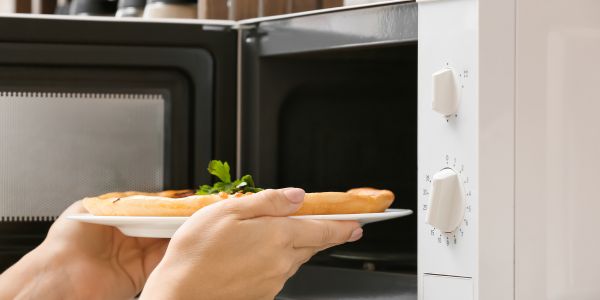
The microwave time for heating food on a ceramic plate can vary depending on factors such as the type of food, portion size, microwave wattage, and starting temperature. However, there are some general guidelines you can follow to determine microwave times for different types of food on a ceramic plate:
- Leftovers: For reheating leftovers, start with short time intervals, typically around 1-2 minutes, depending on the quantity of food. Stirring the food midway can help distribute the heat evenly. Check the temperature of the food and adjust the time as needed until it’s heated to your desired level.
- Frozen Meals: If you’re microwaving a frozen meal on a ceramic plate, follow the instructions on the packaging. Frozen meals often provide recommended microwave times and power levels for optimal heating.
- Fresh Ingredients: For cooking raw ingredients on a ceramic plate, such as vegetables or meat, again, start with shorter time intervals. Cooking times can range from 1-5 minutes or more, depending on the type of food and its thickness. Check for doneness and safety (reaching the proper internal temperature) before consuming.
- Beverages: If you’re using a ceramic plate to warm beverages, like coffee or tea, a minute or less is usually sufficient, as long as you’re not overfilling the cup to avoid spillage.
- Baking: If you’re using a ceramic plate for baking certain dishes in the microwave, like mug cakes, the baking time can vary widely based on the recipe. Refer to the specific recipe instructions for accurate timing.
Remember these general tips when microwaving on a ceramic plate:
- Always start with shorter time intervals to prevent overcooking or overheating the food.
- Stirring food or rearranging items on the plate can help distribute heat evenly.
- Monitor the food closely during microwaving to prevent overheating or burning.
- If you’re unsure, it’s safer to slightly underheat the food and then microwave for additional time if needed.
Keep in mind that microwave wattages can vary, so it’s essential to become familiar with how your specific microwave performs. When microwaving, prioritize safety and follow recommended guidelines for specific foods to achieve the best results.
FAQ’s
Certainly, here are 10 frequently asked questions (FAQs) about the safety of using ceramic plates in the microwave:
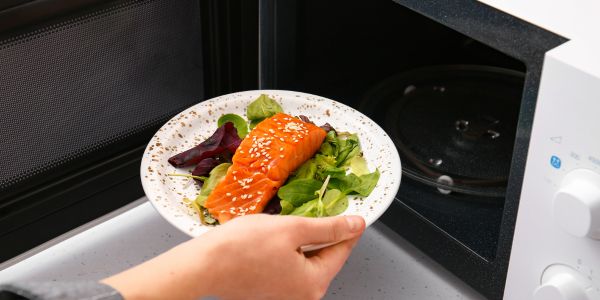
Are all ceramic plates safe to use in the microwave?
No, not all ceramic plates are safe for microwave use. It depends on factors like the glaze quality and presence of metallic elements.
How can I tell if my ceramic plate is microwave safe
You can perform a microwave test: Microwave the plate alongside a microwave-safe glass of water for a short time. If the plate remains cool to the touch, it’s likely microwave-safe.
Can I microwave food directly on a ceramic plate?
Yes, you can microwave food directly on a microwave-safe ceramic plate. Ensure the plate meets the safety criteria and follow safe microwave practices.
Why do some ceramic plates crack in the microwave?
Ceramic plates can crack in the microwave due to poor glaze quality, imperfections in the ceramic, extreme temperature changes, or the presence of metallic elements.
What should I do if my ceramic plate gets hot in the microwave?
If your ceramic plate gets hot in the microwave, it might not be microwave-safe. Stop using it for microwave heating to avoid potential cracking or safety risks.
Can I use ceramic plates with metallic designs or accents in the microwave?
It’s generally not recommended to microwave ceramic plates with metallic designs or accents, as metallic elements can cause sparking and damage to both the plate and the microwave.
What do I do if my microwave-safe ceramic plate cracks or breaks?
Discard ceramic plates that have cracked or broken, as they can be unsafe for microwave use. Use only intact and undamaged plates.
Can I cover food with plastic wrap on a ceramic plate while microwaving?
Yes, you can use microwave-safe plastic wrap to cover food on a ceramic plate while microwaving. Ensure the plastic wrap is labeled as microwave-safe.
Are there any specific guidelines for microwaving ceramic plates with high wattage microwaves?
If you have a high wattage microwave, reduce the microwaving time or use lower power settings to prevent overcooking or overheating the food on the ceramic plate.
Are there any foods I should avoid microwaving on ceramic plates?
Avoid microwaving foods with high oil or fat content for an extended period on ceramic plates, as this can lead to overheating and potential safety issues.
Remember that while ceramic plates can be safe for microwave use, it’s crucial to follow manufacturer instructions, perform the microwave test, and practice safe microwave habits to prevent accidents and ensure the longevity of both your ceramic plates and microwave appliance.
Conclusion:
Ceramic plates can be microwave safe, but it’s essential to consider their composition, quality of glaze, and any metallic elements they might contain. Conducting a microwave test and following the manufacturer’s guidelines are excellent ways to ensure safe usage.
By adhering to these guidelines and being mindful of temperature changes and plate conditions, you can confidently and safely use ceramic plates in your microwave for everyday cooking and heating needs. Remember, a little caution can go a long way in ensuring a trouble-free and enjoyable cooking experience.